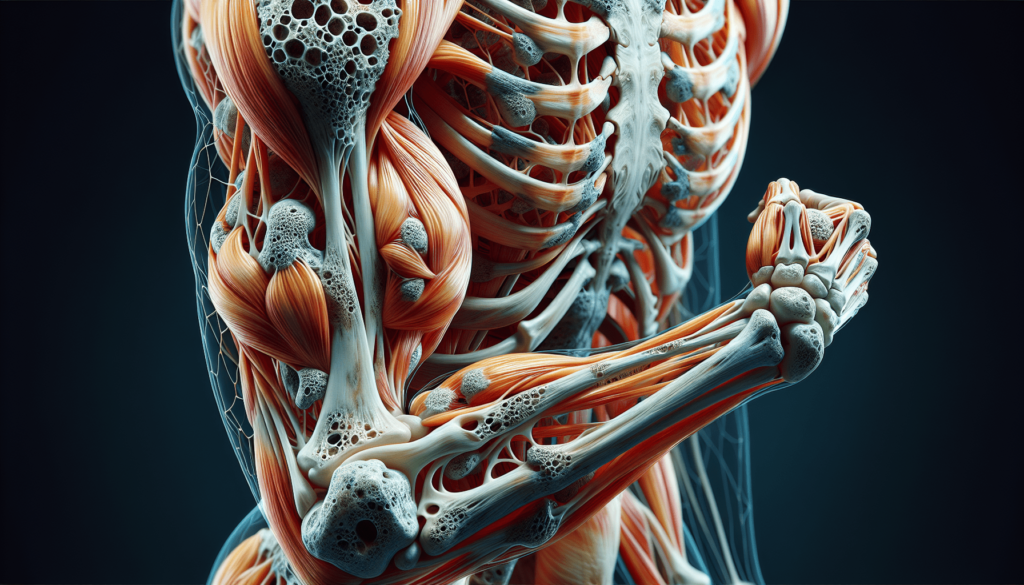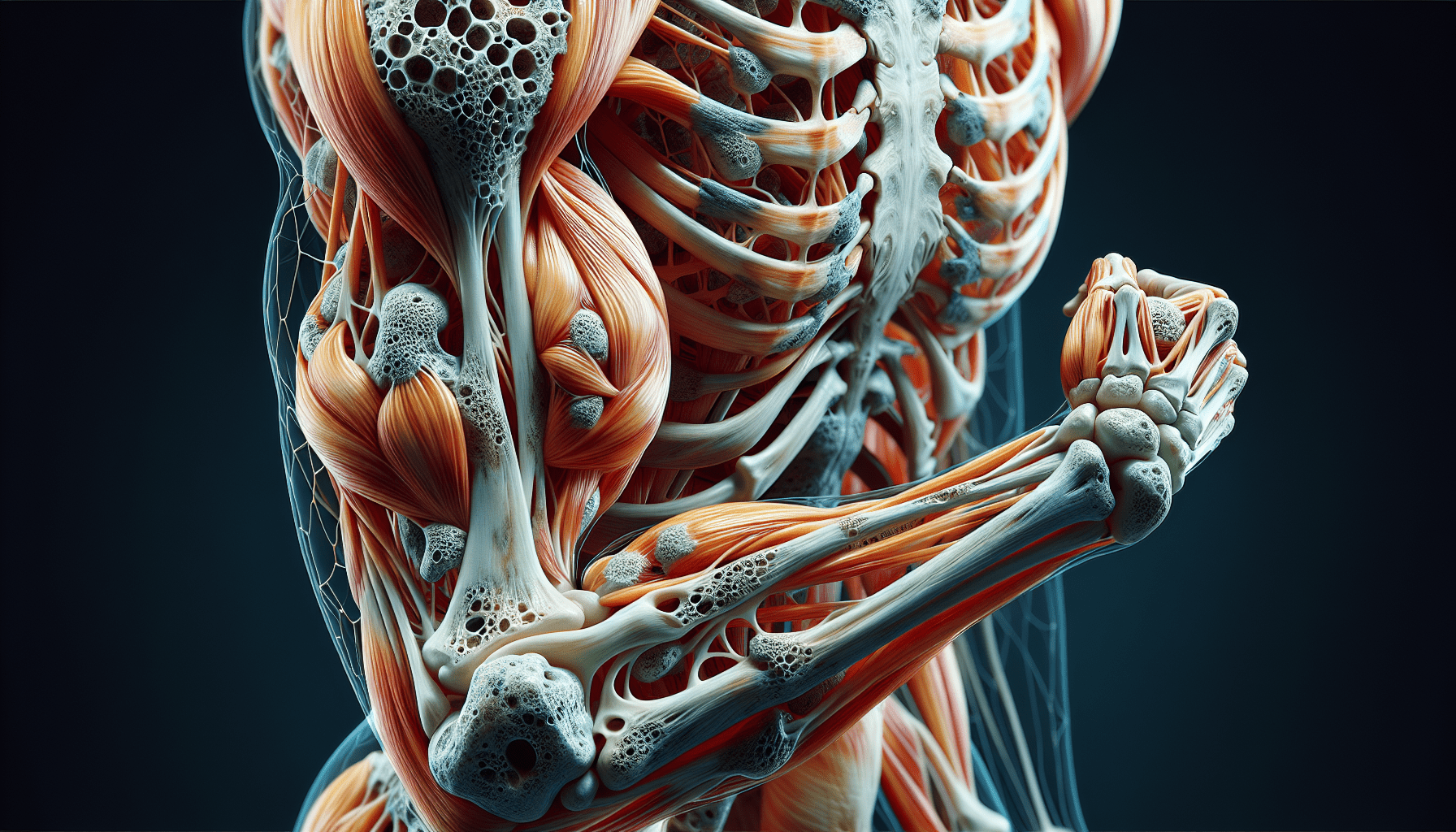Osteoporosis Prevention
As an Amazon Associate I earn from qualifying purchases.
You might not realize it, but your bones play a crucial role in your overall health and well-being. Strong and healthy bones provide support, protect your vital organs, and allow you to move freely. However, as you age, your bones become more brittle and prone to fractures, which is where osteoporosis comes into the picture. Osteoporosis is a condition that weakens your bones, making them more susceptible to breaks. But fear not, because there are steps you can take to prevent osteoporosis and maintain healthy bones. In this article, we will explore some simple yet effective strategies to keep your bones strong and reduce the risk of developing osteoporosis as you age.

Maintaining a Calcium-rich Diet
Importance of calcium for bone health
Calcium plays a crucial role in maintaining strong and healthy bones. It is an essential mineral that helps to build and maintain bone density, reducing the risk of osteoporosis. Calcium also plays a role in other bodily functions such as muscle contractions, nerve function, and blood clotting. Ensuring you have an adequate intake of calcium is key to promoting optimal bone health and preventing the onset of osteoporosis.
Recommended calcium intake
The recommended daily intake of calcium varies depending on age and sex. For adults aged 19-50, the recommended amount is 1000 mg per day for both men and women. However, women over the age of 50 and men over the age of 70 should aim for slightly higher levels, with a recommended intake of 1200 mg per day. It is important to note that these recommendations may vary depending on individual circumstances, so consulting with a healthcare professional is always advised.
Calcium-rich foods and beverages
Including calcium-rich foods in your diet is an effective way to ensure you meet your daily calcium requirements. Dairy products such as milk, cheese, and yogurt are excellent sources of calcium. However, for those who are lactose intolerant or follow a vegan diet, there are numerous alternative sources available. These include leafy green vegetables such as kale and broccoli, fortified plant-based milk, tofu, almonds, and sardines.
Supplementing calcium when necessary
In some cases, it may be necessary to supplement calcium intake to meet the recommended levels. This is particularly true for individuals who have difficulty consuming enough calcium-rich foods or those with specific dietary restrictions. Calcium supplements are available in various forms such as calcium carbonate and calcium citrate. It is important to consult with a doctor or registered dietitian before starting any supplementation to ensure the correct dosage and avoid any potential interactions with other medications.
Adequate Vitamin D Levels
Significance of vitamin D for bone health
Vitamin D is essential for the body’s ability to absorb calcium and ensure proper bone development and maintenance. Without adequate levels of vitamin D, the body may struggle to absorb sufficient calcium, even if it is consumed in adequate amounts. This can lead to weakened bones and an increased risk of fractures. Vitamin D also plays a role in supporting immune function and overall well-being.
Sources of vitamin D
The primary source of vitamin D is sunlight, as the skin naturally produces this vitamin when exposed to sunlight. Spending just 10-15 minutes in the sun each day can help maintain healthy vitamin D levels. However, it is important to protect the skin from sun damage by wearing sunscreen and seeking shade during peak hours. Vitamin D can also be obtained through dietary sources such as fatty fish (e.g., salmon, mackerel), egg yolks, fortified dairy products, and fortified cereals.
Recommended vitamin D levels
The recommended daily intake of vitamin D varies depending on age and specific health conditions. For most adults, a daily intake of 600-800 international units (IU) is typically recommended. However, individuals with certain medical conditions or those who are at a higher risk for vitamin D deficiency may require higher dosages. It is best to consult with a healthcare professional to determine the appropriate dosage for your individual needs.
Supplementing vitamin D when necessary
In cases where you are unable to obtain sufficient vitamin D through sunlight and dietary sources alone, supplementation may be necessary. Vitamin D supplements come in a variety of forms, such as capsules or liquid drops. It is important to follow the recommended dosage and consult with a healthcare professional to ensure optimal absorption and avoid potential interactions with other medications.
Regular Physical Activity
Benefits of exercise for bone density
Engaging in regular physical activity is not only important for overall health but also for maintaining and improving bone density. Weight-bearing exercises, resistance exercises, and aerobic exercises all have unique benefits for promoting bone health. Regular exercise can help increase bone mass and strength, reduce the risk of fractures, improve balance and coordination, and enhance overall physical fitness.
Weight-bearing exercises
Weight-bearing exercises are activities that involve supporting body weight through the feet and legs. Examples of weight-bearing exercises include walking, jogging, dancing, hiking, and stair climbing. These exercises stimulate bone-building cells and stimulate bone remodeling, helping to maintain and improve bone density.
Resistance exercises
Resistance exercises, such as weightlifting or using resistance bands, help to strengthen and increase the mass of muscles and bones. These exercises create tension on the bones, promoting bone growth and improving bone density. Resistance exercises should be performed with proper form and technique to prevent injury and maximize the benefits.
Aerobic exercises
Aerobic exercises, also known as cardiovascular exercises, are beneficial for overall health and bone density. Activities such as swimming, cycling, and brisk walking can help improve cardiovascular fitness, which indirectly promotes bone health. Although aerobic exercises are not weight-bearing, they offer a range of benefits for overall bone density and general well-being.
Safe exercise routines
When engaging in physical activity, it is important to start gradually and progress at a pace that is comfortable for you. Always warm up before exercise and cool down afterward to prevent injury. If you have any pre-existing medical conditions or are unsure about which exercises are suitable for you, consult with a healthcare professional or a certified exercise physiologist to develop a safe and effective exercise routine.

Avoiding Excessive Alcohol Consumption
Negative effects of alcohol on bone health
Excessive alcohol consumption can negatively impact bone health and increase the risk of osteoporosis. Alcohol interferes with the body’s ability to absorb calcium, effectively reducing bone density over time. It also affects the production of vitamin D, which is crucial for proper calcium absorption. Additionally, alcohol consumption can increase the risk of falls and accidents, further endangering bone health.
Recommended alcohol limits
To maintain optimal bone health, it is recommended to consume alcohol in moderation. The Centers for Disease Control and Prevention (CDC) defines moderate drinking as up to one drink per day for women and up to two drinks per day for men. It is important to note that excessive alcohol consumption and binge drinking can have significant negative impacts on bone health and overall well-being.
Tips for reducing alcohol consumption
If you find it difficult to reduce your alcohol consumption, there are several strategies that can help. Firstly, set clear goals for cutting back and gradually decrease your intake over time. Seek support from friends, family, or support groups who can provide encouragement and accountability. Find alternative activities to engage in that do not involve alcohol, such as hobbies, exercise, or spending time with loved ones. If you are struggling with alcohol addiction, reach out to a healthcare professional or addiction specialist for specialized guidance and support.
Quitting Smoking
Impact of smoking on bone health
Smoking has been linked to a variety of health issues, including negative effects on bone health. Smoking reduces the production of estrogen in women, which is vital for maintaining bone density. It also affects the absorption of calcium and disrupts the natural bone-building process. These factors increase the risk of developing osteoporosis and experiencing fractures.
Methods and resources for quitting smoking
Quitting smoking can be challenging, but it is crucial for both your overall health and bone health. There are numerous methods and resources available to assist with smoking cessation. Consider reaching out to healthcare professionals, such as doctors or counselors, who can provide guidance and support. Nicotine replacement therapies, medications, and behavioral therapy have also proven effective in helping individuals quit smoking. Support groups and online communities can also offer valuable encouragement and advice during the quitting process.
Evaluating Medications and Health Conditions
Medications that can affect bone density
Certain medications can have a negative impact on bone density and increase the risk of osteoporosis. These medications include corticosteroids, anticonvulsants, aromatase inhibitors, proton pump inhibitors, and some antidepressants. Long-term use of these medications may lead to reduced bone density and increased fracture risk. If you are taking any medications long-term, it is important to discuss potential side effects and risks with your healthcare provider.
Consulting healthcare professionals about medication side effects
When prescribed medications, it is important to consult with your healthcare professional about any potential side effects on bone health. They can provide guidance on lifestyle modifications or recommend alternative medications that may have fewer negative effects on bone density. Regular check-ups and open communication with healthcare professionals will help ensure that your treatment plans consider your bone health and overall well-being.
Health conditions linked to osteoporosis
Certain health conditions can increase the risk of developing osteoporosis. These include hormonal disorders, such as hypogonadism or hyperthyroidism, gastrointestinal disorders that affect nutrient absorption, chronic kidney or liver disease, and autoimmune conditions such as rheumatoid arthritis. If you have any of these conditions, it is important to work closely with your healthcare team to manage them effectively and minimize the impact on bone health.
Managing health conditions to prevent osteoporosis
If you have a health condition that increases the risk of osteoporosis, it is important to take proactive measures to maintain bone health. This can include regular monitoring of bone density, appropriate medication management, and lifestyle modifications such as maintaining a calcium-rich diet, ensuring adequate vitamin D levels, engaging in weight-bearing exercises, and avoiding excessive alcohol consumption and smoking. Working closely with your healthcare team will help create a comprehensive plan to manage your health condition and prevent osteoporosis.
Maintaining a Healthy Body Weight
Relationship between body weight and bone health
Maintaining a healthy body weight is essential for optimal bone health. Being underweight can increase the risk of osteoporosis because the body lacks the necessary fat stores and nutrient reserves to support bone density. On the other hand, being overweight or obese can also negatively affect bone health, as excess body weight puts additional stress and strain on the bones. Striking a balance and maintaining a healthy body weight is key to promoting and preserving bone density.
Balanced diet and regular exercise for weight management
To maintain a healthy body weight, a balanced diet and regular exercise are crucial. Ensuring a well-rounded diet that includes lean proteins, fruits, vegetables, whole grains, and healthy fats can help provide the necessary nutrients to support bone health and manage weight. Regular exercise, including both cardiovascular activities and strength training exercises, can help burn calories, build muscle mass, and improve overall fitness. All of these components work together to support healthy weight management and optimal bone health.
Avoiding Falls and Injuries
Consequences of falls and injuries for bone health
Falls and injuries can have severe consequences for bone health, especially in individuals with osteoporosis. Fractures, particularly in the hip, wrist, or spine, can lead to significant pain, decreased mobility, and reduced quality of life. Falls are more common in older adults, but it is essential to take precautions at any age to prevent accidents and minimize the risk of fractures.
Home safety measures
Taking steps to make your home safer can greatly reduce the risk of falls and injuries. Ensure adequate lighting in all areas of the home, especially hallways, staircases, and bathrooms. Remove any tripping hazards, such as loose rugs or clutter on the floor. Install handrails and grab bars in areas where assistance is needed, such as the bathroom. Using non-slip mats in the bathtub or shower can also help prevent falls. Regularly checking for and fixing any loose or uneven flooring or steps is essential as well.
Exercises to improve balance and coordination
Engaging in exercises that improve balance and coordination can be instrumental in preventing falls and injuries. Activities such as yoga, tai chi, and balance training exercises can help strengthen leg muscles, improve stability, and enhance overall coordination. These exercises focus on body awareness, posture, and controlled movements, all of which contribute to better balance and a reduced risk of falls.
Getting Regular Bone Density Tests
Importance of bone density testing
Regular bone density testing, also known as a bone mineral density (BMD) test or DEXA scan, is crucial for identifying changes in bone density and detecting osteoporosis or osteopenia. These tests provide valuable information about bone health and help assess the risk of fractures. Early detection allows for prompt intervention and implementation of preventative measures to maintain bone health.
Recommended age to start receiving tests
The recommended age to start receiving bone density tests varies depending on individual risk factors and medical history. Women over the age of 65 and men over the age of 70 are generally recommended to undergo a bone density test. However, individuals with specific risk factors, such as a family history of osteoporosis, prolonged corticosteroid use, or certain medical conditions, may need testing at an earlier age. It is important to discuss with a healthcare professional to determine the appropriate age to start receiving tests based on individual circumstances.
Frequency of bone density tests
The frequency of bone density tests also depends on various factors such as age, initial bone density results, and risk factors for osteoporosis. In general, most individuals should receive a bone density test every two years. However, if you have a diagnosis of osteoporosis or have experienced fractures, more frequent testing may be necessary. Healthcare professionals can assess your individual situation and provide guidance on the optimal frequency for bone density testing.
Educating Yourself about Osteoporosis
Understanding osteoporosis: causes and risk factors
Educating yourself about osteoporosis is key to understanding the causes, risk factors, and preventative measures associated with this condition. Osteoporosis is a bone disease characterized by low bone density and an increased risk of fractures. It is most commonly seen in postmenopausal women, but it can also affect men and individuals of any age. Risk factors for osteoporosis include advancing age, female gender, smoking, excessive alcohol consumption, certain medical conditions, and a family history of the disease.
Recognizing early signs and symptoms
Early detection and intervention are crucial in managing osteoporosis. While osteoporosis itself may not present obvious symptoms until a fracture occurs, there are certain signs that may indicate compromised bone health. These can include height loss, a stooped or hunched posture (kyphosis), back pain, and a higher frequency of fractures from minor falls or impacts. Recognizing these signs and discussing any concerns with a healthcare professional can lead to early intervention and appropriate treatment.
Seeking professional advice and support
If you have concerns about osteoporosis or wish to learn more about prevention, it is essential to seek professional advice and support. Healthcare professionals, such as doctors, registered dietitians, or osteoporosis specialists, can provide valuable information, assess your individual risk factors, and guide you in developing a personalized prevention plan. Support groups and online resources can also offer additional information, personal stories, and a sense of community for individuals seeking support and encouragement on their osteoporosis prevention journey.
By following these comprehensive guidelines for osteoporosis prevention, you can take proactive steps to maintain optimal bone health and reduce the risk of fractures. Remember to consult with healthcare professionals regarding individual circumstances and specific health conditions to ensure the best plan of action for your long-term bone health. With proper nutrition, exercise, lifestyle modifications, and regular monitoring, you can promote strong and healthy bones throughout your life.
Amazon and the Amazon logo are trademarks of Amazon.com, Inc, or its affiliates.






